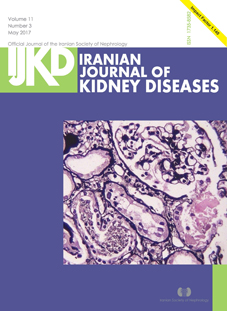Role of Donors and Recipients’ Glutathione S-Transferase Gene Polymorphisms in Association of Oxidative Stress With Delayed Graft Function in Kidney Allograft Recipients
Abstract
Introduction. Oxidative stress contributes to delayed graft function (DGF). Glutathione S-transferases (GSTs) are polymorphic genes which produce enzymes with protective effect against oxidative stress. This study aimed to investigate the association between donors' and recipients' GSTM1 and GSTT1 polymorphisms and DGF, creatinine clearance, and oxidative stress parameters in kidney allograft recipients.
Materials and Methods. One hundred and eighty-two donor-recipient pairs were studied. Lipid peroxidation and total antioxidant capacity were measured in the recipients' plasma as the parameters of oxidative stress. Delayed graft function was determined based on at least 10% increase, no change, or less than 10% decrease in the serum creatinine level in 3 consecutive days during the 1st week after transplantation.
Results. Lipid peroxidation was significantly greater in the recipients with DGF (P < .001). The frequency of GSTM1 null was significantly higher in the patients with DGF (odds ratio [OR], 0.38; 95% confidence interval [CI], 0.17 to 0.86; P = .02). There was also a significant association between the donors' GSTM1 polymorphism and DGF (OR, 0.31; 95% CI, 0.14 to 0.68; P = .003). A significant association was detected between combination of recipients and donors' GSTM1 polymorphism and DGF (OR, 0.20; 95% CI, 0.07 to 0.64, P = .006). The recipients' GSTM1 polymorphism, alone and in combination with donors' GSTM1 and GSTT1, significantly affected the creatinine clearance on discharge day.
Conclusions. These results suggest that the donors and recipients' GSTM1 polymorphism may be a major risk factor for oxidative stress and poor kidney allograft transplantation outcomes.


